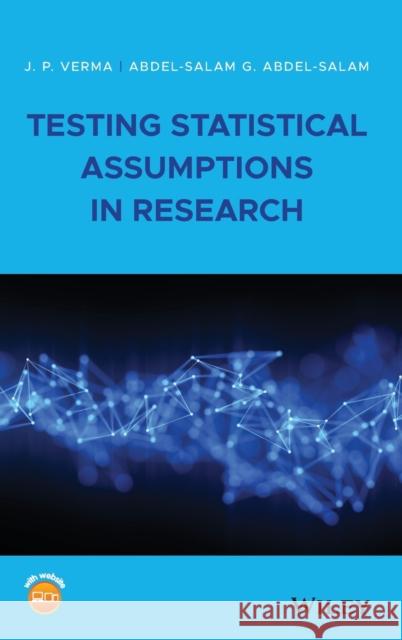Testing Statistical Assumptions in Research » książka



Testing Statistical Assumptions in Research
ISBN-13: 9781119528418 / Angielski / Twarda / 2019 / 224 str.
Testing Statistical Assumptions in Research
ISBN-13: 9781119528418 / Angielski / Twarda / 2019 / 224 str.
(netto: 443,91 VAT: 5%)
Najniższa cena z 30 dni: 463,24
ok. 30 dni roboczych
Dostawa w 2026 r.
Darmowa dostawa!
Preface ixAcknowledgments xiAbout the Companion Website xii1 Importance of Assumptions in Using Statistical Techniques 11.1 Introduction 11.2 Data Types 21.2.1 Nonmetric Data 21.2.2 Metric Data 21.3 Assumptions About Type of Data 31.4 Statistical Decisions in Hypothesis Testing Experiments 41.4.1 Type I and Type II Errors 51.4.2 Understanding Power of Test 61.4.3 Relationship Between Type I and Type II Errors 71.4.4 One-Tailed and Two-Tailed Tests 81.5 Sample Size in Research Studies 81.6 Effect of Violating Assumptions 11Exercises 12Answers 162 Introduction of SPSS and Segregation of Data 172.1 Introduction 172.2 Introduction to SPSS 172.2.1 Data File Preparation 192.2.2 Importing the Data Set from Excel 212.3 Data Cleaning 232.3.1 Interpreting Descriptive Statistics Output 262.3.2 Interpreting Frequency Statistic Output 272.4 Data Management 272.4.1 Sorting Data 282.4.1.1 Sort Cases 282.4.1.2 Sort Variables 292.4.2 Selecting Cases Using Condition 312.4.2.1 Selecting Data of Males with Agree Response 322.4.3 Drawing Random Sample of Cases 342.4.4 Splitting File 362.4.5 Computing Variable 36Exercises 40Answers 423 Assumptions in Survey Studies 453.1 Introduction 453.2 Assumptions in Survey Research 463.2.1 Data Cleaning 463.2.2 About Instructions in Questionnaire 463.2.3 Respondent's Willingness to Answer 473.2.4 Receiving Correct Information 473.2.5 Seriousness of the Respondents 473.2.6 Prior Knowledge of the Respondents 483.2.7 Clarity About Items in the Questionnaire 483.2.8 Ensuring Survey Feedback 483.2.9 Nonresponse Error 483.3 Questionnaire's Reliability 493.3.1 Temporal Stability 493.3.1.1 Test-Retest Method 493.3.2 Internal Consistency 503.3.2.1 Split-Half Test 503.3.2.2 Kuder-Richardson Test 523.3.2.3 Cronbach's Alpha 55Exercise 60Answers 634 Assumptions in Parametric Tests 654.1 Introduction 654.2 Common Assumptions in Parametric Tests 664.2.1 Normality 664.2.1.1 Testing Normality with SPSS 674.2.1.2 What if the Normality Assumption Is Violated? 714.2.1.3 Using Transformations for Normality 724.2.2 Randomness 744.2.2.1 Runs Test for Testing Randomness 754.2.3 Outliers 764.2.3.1 Identifying Outliers with SPSS 774.2.4 Homogeneity of Variances 794.2.4.1 Testing Homogeneity with Levene's Test 794.2.5 Independence of Observations 824.2.6 Linearity 824.3 Assumptions in Hypothesis Testing Experiments 824.3.1 Comparing Means with t-Test 834.3.2 One Sample t-Test 834.3.2.1 Testing Assumption of Randomness 844.3.2.2 Testing Normality Assumption in t-Test 854.3.2.3 What if the Normality Assumption Is Violated? 884.3.3 Sign Test 884.3.4 Paired t-Test 884.3.4.1 Effect of Violating Normality Assumption in Paired t-Test 914.3.5 Rank Test 914.3.6 Independent Two-Sample t-Test 924.3.6.1 Two-Sample t-Test with SPSS and Testing Assumptions 924.3.6.2 Effect of Violating Assumption of Homogeneity 964.4 F-test For Comparing Variability 974.4.1 Analysis of Variance (ANOVA) 984.4.2 ANOVA Assumptions 994.4.2.1 Checking Assumptions Using SPSS 994.4.3 One-Way ANOVA Using SPSS 1054.4.4 What to Do if Assumption Violates? 1094.4.5 What if the Assumptions in ANOVA Are Violated? 1094.5 Correlation Analysis 1184.5.1 Karl Pearson's Coefficient of Correlation 1184.5.2 Testing Assumptions with SPSS 1194.5.2.1 Testing for Linearity 1194.5.3 Coefficient of Determination 1224.6 Regression Analysis 1254.6.1 Simple Linear Regression 1264.6.2 Assumptions in Linear Regression Analysis 1284.6.2.1 Testing Assumptions with SPSS 128Exercises 136Answers 1395 Assumptions in Nonparametric Tests 1415.1 Introduction 1415.2 Common Assumptions in Nonparametric Tests 1415.2.1 Randomness 1425.2.2 Independence 1425.2.2.1 Testing Assumptions Using SPSS 1425.2.2.2 Runs Test for Randomness Using SPSS 1435.3 Chi-square Tests 1445.3.1 Goodness-of-Fit Test 1455.3.1.1 Assumptions About Data 1455.3.1.2 Performing Chi-square Goodness-of-Fit Test Using SPSS 1465.3.2 Testing for Independence 1485.3.2.1 Assumptions About Data 1485.3.2.2 Performing Chi-square Test of Independence Using SPSS 1485.3.3 Testing for Homogeneity 1525.3.3.1 Assumptions About Data 1535.3.3.2 Performing Chi-square Test of Homogeneity Using SPSS 1535.3.4 What to Do if Assumption Violates? 1555.4 Mann-Whitney U Test 1565.4.1 Assumption About Data 1575.4.2 Mann-Whitney Test Using SPSS 1575.4.3 What to Do if Assumption Violates? 1595.5 Kruskal-Wallis Test 1615.5.1 Assumptions About Data 1625.5.2 Kruskal-Wallis H Test Using SPSS 1625.5.3 Dealing with Data When Assumption Is Violated 1665.6 Wilcoxon Signed-Rank Test 1685.6.1 Assumptions About Data 1685.6.2 Wilcoxon Signed-Rank Test Using SPSS 1685.6.3 Remedy if Assumption Violates 172Exercises 172Answers 1746 Assumptions in Nonparametric Correlations 1756.1 Introduction 1756.2 Spearman Rank-Order Correlation 1756.3 Biserial Correlation 1786.4 Tetrachoric Correlation 1826.4.1 Assumptions for Tetrachoric Correlation Coefficient 1826.4.1.1 Testing Significance 1836.5 Phi Coefficient (Phi) 1846.6 Assumptions About Data 1886.7 What if the Assumptions Are Violated? 188Exercises 188Answers 190Appendix Statistical Tables 193Bibliography 203Index 209
J. P. VERMA, PHD, is Professor of Statistics and Dean of Students Welfare at Lakshmibai National University of Physical Education, India. He is the author of Sports Research with Analytical Solution using SPSS, Repeated Measures Design for Empirical Researchers, and Statistics for Exercise Science and Health with Microsoft Office Excel.ABDEL-SALAM G. ABDEL-SALAM, PHD, is Assistant Professor of Statistics and Head of Student Data Management Section and Coordinator for the Statistical Consulting Unit at Qatar University, Qatar. He is a PStat(r) by the American Statistical Association and CStat by the Royal Statistical Society. He taught at different international universities such as; Virginia Polytechnic Institute and State University (Virginia Tech), Oklahoma State University and Cairo University.
1997-2025 DolnySlask.com Agencja Internetowa
KrainaKsiazek.PL - Księgarnia Internetowa









